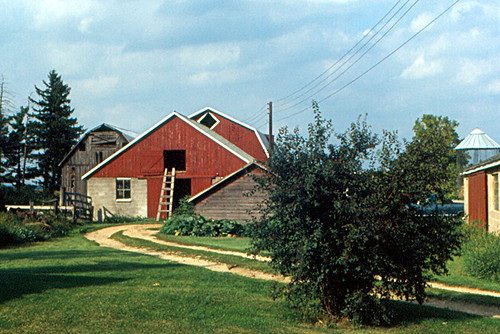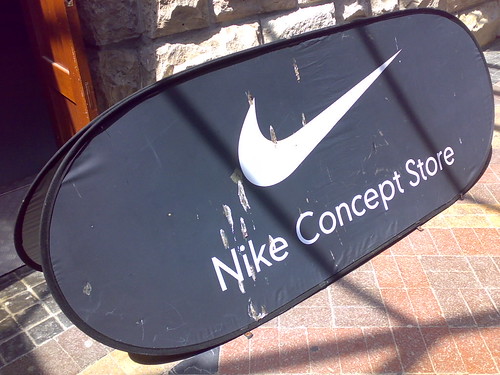Stump Ridge Farm - "The Barn Came First"
Image by roger4336
My cousins T. J. (Punk) and Pearl Swiggum bought this farm, called Stump Ridge Farm, in the 1960s. It had been owned by Pearl's uncle. It is in southern Vernon County, Wisconsin, just north of the Crawford County line and south of Viroqua. It is on Stump Ridge Road, which may the the source of the name. Punk and Pearl rebuilt the farm and house after buying it.
Pearl wrote a weekly column about farm life in a local newspaper for 45 years, and became something of a celebrity in southwestern Wisconsin. She wrote two books with excerpts from her columns. The second one was titled, "The Barn Came First." Punk and Pearl brought the barn and other farm buildings up to standard before rebuilding the house.
Punk and Pearl eventually retired from farming, and sold or rented most of the farmland. The barn then became a home for Pearl's cats.
johnny cash port richey house
Image by the past tends to disappear
According to the recollection of Des Little (below), Ezra J. “Pop” Carter and “Mother” Maybelle Carter purchased this house in Port Richey in 1962. According to Jeff Cannon, county records indicate that the Carters bought the home in February 1966.
Will You Miss Me When I’m Gone? The Carter Family and Their Legacy in American Music by Mark Zwonitzer and Charles Hirshberg has:
Pop Carter had been thinking about it for a while, researching it in consumer magazines. He’d decided it was time to retire, and according to his research, New Port Richey, Florida, was the place to go; the little fishing village just north of Tampa was the best value the country offered. He found a bungalow there, on a crystal-clear freshwater river, a short boat ride away from the Gulf of Mexico. The fishing was great. Heck, he already had the deep-sea poles. So one night in 1961, Pop made his announcement. “Mom came in off the road, and he had decided that it was time for them to retire and go to Florida,” says Becky Bowman. “And he had already bought a place and made two trips with his truck moving stuff down there!”
Their daughter June Carter married Johnny Cash in 1968. Johnny Cash visited Port Richey on numerous occasions. The photo above, from a post card postmarked in 1915, shows the historic house which in the early days was owned by A. S. Leach and later Morgan Davis. The photo to the left shows the house in 2002.
When he died in 1975, the New Port Richey Press reported that Ezra J. “Pop” Carter “was a frequent visitor to the Port Richey area where he owned a house on the Pithlachascotee River. ... While in Port Richey, he spent most of his time fishing and writing music.”
In Cash: The Autobiography (1998), Johnny Cash wrote, “Several names, several homes. I'm part gypsy, part homebody, so I live according to a rhythm alien to most people but natural to me, splitting my time on a semi-predictable basis between my big house on Old Hickory Lake just outside Nashville; my farm at Bon Aqua, farther outside Nashville; the house in Port Richey, Florida, that June inherited from her parents; an endless succession of hotels all over the world; my bus; and my house in Jamaica, Cinnamon Hill.”
He also wrote:
Today I'm in Florida with June at the little house she inherited from her parents, Ezra and Maybelle Carter. ...
Their house is in Port Richey, a community identified by Consumer Reports in 1961 as the best and cheapest place to live in the whole United States. That’s what prompted Ezra, or Pop Carter as we all called him, to come looking for property, find this house on the river, and begin negotiating. About a year later he'd talked the owner into a good deal.
Naturally, many other citizens followed the beacon lit by Consumer Reports, and in short order Port Richey began growing at such an explosive rate that very soon it lost many of the qualities that made it so desirable in the first place. These days it’s just one in a string of little coastal towns that have blended into a solidly urbanized strip running forty miles, north to south, between U. S. 19 and the Gulf of Mexico. The highway is so clogged with traffic most of the time that people talk about it the way Californians talk about earthquakes or New Yorkers talk about crime, and in some of the souvenir shops you can buy T-shirts boasting I Survived U. S. 19.
Still, once you're on our little street, on Pop Carter’s front porch with the river right across the pavement from you and your boat bobbing at the dock, waiting to zoom you out into the open waters of the Gulf just a few hundred yards away, all that stuff could be in another country. Here you have the tide, the meeting of freshwater with salt, the seabirds and marsh birds and land birds. The weather cooks up its sudden subtropical tempests out over the horizon or, on the landward side, takes the whole afternoon to build one of those immense, imposing fortresses of thunderheads, and then, as afternoon begins its long transition to evening, turns the whole towering edifice purple-gray and brings it all tumbling and crashing down on you, transforming everything into wind and water. Mostly that’s a summer treat, so I don't experience it very often, for like other nonnatives with enough money and sense, we go elsewhere during Florida’s months of eighty percent humidity. Whenever I see it, though, it always makes me marvel: at the sheer scale, power, beauty, and complexity of God’s creation, at the simplicity and strength of my human root in nature.
The house itself is quite and comfortable, and it’s not at all grand in the manner of Cinnamon Hill or our main home on Old Hickory Lake. It’s just a regular Florida family bungalow from the early part of this century — 1912, I believe — wood-framed, with painted clapboard and a big screen porch in front. It reminds me a lot of the farmhouses you see in the hotter, more northerly parts of Australia. Unlike there, though, our neighbors are close. Next door is only twenty feet away. That helps us feel less like celebrities, and the people in the neighborhood help in that regard, too. They're friendly, but they allow us our peace and quiet. Strangers knock on the door sometimes, wanting to say hello or get an autograph, but not often enough to bother us.
The house inside is a maze. The rooms aren't very big, and most of them are decorated and furnished very much like they were in Pop and Maybelle’s day, with many of Pop and Maybelle’s things still in place. Which is good; it feels right to have such a palpable connection to them and their days. At times when our money has gotten tight, we've seriously considered selling the place (as we have Cinnamon Hill), but we've never absolutely had to, and I'm glad we've always decided to keep it. It belongs in the family.
This is what the pigeons think of the Nike Concept Store at the V&A
Image by *spo0ky*
Dplanet wrote this...
The Nike Concept Store.
The bird shit on this sign perfectly sums up my experience at the Nike Concept Store at the V&A Waterfront in Cape Town.
It is hard to imagine what the 'concept' of the Nike Concept Store actually is? After visiting it, I can only imagine it is an attempt to create the world's most sterile and soulless retail space.
Saturday afternoon at the Waterfront (the most visited 'attraction' in Africa apparently) and the concept store is dead. Mind shatteringly distorted European techno blasts out of the woeful sound system. When my mind has adjusted to the unpleasant noise, I am confronted with a totally bland retail space that contains Nike's typical low-end product range.
I'm there to buy some Air Force 1s so I head straight for the footwear section. I can quickly see that there are only 4 colourways to choose from and nothing from the premium range. I can quickly see that there is nothing of any interest to me.
By this time I have 3 depressed looking assistants hovering moribundly around me. As I start walking away one of them asks, "Leaving so soon?", to which I reply, "You've got quite a limited range.". "Oh. OK.", she responds.
There was something so painfully sterile and depressingly dead about the 'concept' store that I couldn't actually wait to get out. The only thing missing was the sound of the wind blowing a tumbleweed through the desolate space. For some reason it actually made me angry.
What is Nike South Africa thinking? Why are they so hopelessly out of touch? They have the opportunity to lead the way by creating an exciting, vibrant and iconic concept space and instead they just reproduce a tired old-fashioned formula.
This is Nike's flagship store in Cape Town. Where's the buzz? Where's the excitement? Where's the theatre? In the Air Force 1, Nike has one of the most iconic and desireable product ranges ever created. They also have a long association with Hip Hop culture and sports celebrities. Why is this not exploited?
I realise that most of the Airforce 1 range is out of the price range of the average South African, but it wouldn't hurt to have a display as a kind of permanent art gallery to generate buzz, and plug into and promote the cult status of the shoe. 'Sneaker culture' is a huge worldwide phenomenon with galleries hosting exhibitions of customised shoes and other homages to the Air Force 1.
A concept store should be more than just a space to sell product, it should be a brand experience.
Some ideas:
- Live DJs
- Live performances by rappers / singers
- Live performances by breakdancers
- Permanent exhibition of Air Force 1 range
- Rare or customised Air Force 1s
- Wider product range and colourways (Air Max 90s etc)
- Host exhibitions (sponsor local artists to customise shoes)
- Juice bar
- Personal appearances by local/ international footballers
- Train dynamic, knowledgeable staff
- Basketball demonstrations / 1 on 1 competitions
- More radical interior design
- Interactive displays
- Expert clinics (ie. running, nutrition etc.)
No comments:
Post a Comment